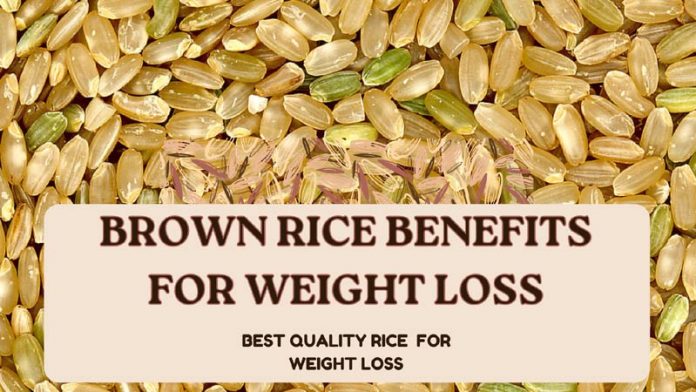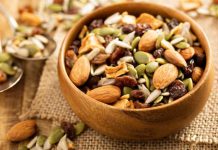Brown rice is the grain in its most natural form. It is picked, cleaned, and toasted before being hulled and polished to remove the bran, making it more nutritious than white rice. Brown grains are high in fiber and B vitamins, with two-thirds of the nutritional value of white rice.
However, many individuals shun brown rice due to the growing popularity of low-carb diets. This article will go through the health advantages of brown rice to help you determine if it’s an excellent meal to incorporate into your diet.
Is brown rice good for weight loss?
White rice, white bread, and white pasta are refined grains that lack the fibre and minerals found in whole grains like brown rice. For example, one cup (158 grams) of brown rice has 3.5 grams of fibre, whereas white rice delivers less than 1 gram. Fiber keeps you satisfied for longer, so eating fiber-rich meals may help you consume fewer calories overall.
Indeed, research indicates that people who consume more whole grains, including brown rice, have less weight than those who consume fewer whole grains. Brown rice can help you lose weight but will not result in spectacular weight loss. To reduce weight, you must change your diet and overall eating habits.
Brown rice lowers glycaemic response. People who are suffering from metabolic syndrome can get benefits by eating brown rice. It helps them to protect postprandial endothelial function. In the research, it was found that BR helps in maintaining metabolic parameters and endothelial function.
How to brown rice aid weight loss?
Brown rice is one of the healthiest grains, so it’s no surprise that it can also help you lose weight. Research shows that brown rice helps reduce your body’s blood sugar and insulin levels, which can help prevent excess fat storage. In addition, it has a low glycaemic index rating, meaning it won’t spike your blood sugar like other carb-heavy foods.
Adding brown rice to the standard diet may help overweight persons lose weight and reduce their BMI, which is a common predictor of healthy or unhealthy weight.
Brown rice is supposed to have more fibre than white rice. Higher-fiber foods satisfy you for longer while eating fewer calories. So you can eat less without feeling hungry if you replace brown rice with white rice.
Nutritional facts for brown rice
When it comes to nutritional value, brown rice outperforms white rice. This superfood has lower calories, fat, and gluten content. As a result, all diet-conscious people prefer this rice to white rice. This rice also provides the following vital nutrients:
- Dietary fibers
- Minerals-zinc, magnesium, iron, calcium, phosphorus, and selenium
- Vitamins-vitamin B1, vitamin B2, vitamin B3, vitamin B6, vitamin E and vitamin K
- Antioxidants-flavonoids
- Proteins
- Essential fatty acids
Difference between brown rice and white rice – Which is healthy?
| Nutrient | Brown Rice (1 cup, cooked) | White Rice (1 cup, cooked) |
|---|---|---|
| Calories | 218 | 205 |
| Protein | 5 g | 4 g |
| Fat | 2 g | 0.4 g |
| Carbohydrates | 46 g | 45 g |
| Fiber | 4 g | 0.6 g |
| Sugar | 0.7 g | 0.1 g |
| Calcium | 19 mg | 15 mg |
| Iron | 1 mg | 1 mg |
| Magnesium | 83 mg | 19 mg |
| Phosphorus | 162 mg | 68 mg |
| Potassium | 84 mg | 55 mg |
| Sodium | 10 mg | 1 mg |
| Zinc | 1 mg | 1 mg |
| Vitamin B1 | 0.2 mg | 0.1 mg |
| Vitamin B2 | 0.1 mg | 0.0 mg |
| Vitamin B3 | 2 mg | 2 mg |
| Vitamin B5 | 1 mg | 0.6 mg |
| Vitamin B6 | 0.3 mg | 0.2 mg |
| Folate | 10 mcg | 15 mcg |
As we can see in the table, brown rice is rich in fiber, magnesium, and vitamin B6. Brown rice also has a lower glycemic index compared to white rice. It means that for people with diabetes, brown rice is better than white rice.
Calories and Carbohydrates in one cup of brown rice
Brown rice outperforms white rice in practically every other area while having similar calories and carbohydrate content.
- Calories: 216
- Carbs: 44 grams
- Fiber: 3.5 grams
- Fat: 1.8 grams
- Protein: 5 grams
- Thiamin (B1): 12% of the RDI
- Niacin (B3): 15% of the RDI
- Pyridoxine (B6): 14% of the RDI
- Pantothenic acid (B5): 6% of the RDI
- Iron: 5% of the RDI
- Magnesium: 21% of the RDI
- Phosphorus: 16% of the RDI
- Zinc: 8% of the RDI
- Copper: 10% of the RDI
- Manganese: 88% of the RDI
- Selenium: 27% of the RDI
*RDI – Reference Daily Intake
Ways to eat brown rice for weight loss
Although brown rice is nutritious, it is also true that eating the same type of steamed rice every day would weary us. So, to add some variety, we’ve compiled a list of recipe ideas from which you may choose to flavour your ordinary rice.
1. Dum biryani with brown rice
You may now have the excellent dum veggie biryani with some low-fat raita for lunch without adding too many calories. It is a simple healthy biryani dish that you should try.
2. Brown Rice Salad
Salad with brown rice and vegetables is a quick and straightforward approach to incorporating brown rice into your regular diet. Combine your favourite vegetables with cooked brown rice and seasonings to enjoy this delightful healthy food.
3. Brown rice with grilled chicken
It is a traditional recipe that everyone enjoys. But, even if you’re not looking to lose weight, you should try this delicious mix of grilled chicken and brown rice. They are both low in calories and abundant in nutrients and can be produced with only a few simple ingredients.
4. Idli with brown rice
Idlis are a favourite since they are not only nutritious but also delicious! Anyone may eat these wonderful brown rice idlis without worrying about their health or weight. Brown rice idli is a better alternative for individuals looking to lose weight.
5. Brown rice khichdi
This classic Indian meal-in-one dish is made of steamed brown rice, vegetables, and lentils.
Brown rice substitutes white rice in traditional Indian dishes like Dosa, Appam, Kheer, and Pongal to continental dishes like Risottos, Pilafs, and Pasta. This nutritious whole grain goes well with various foods and may be eaten for breakfast, lunch, or supper.
Introducing brown rice into your diet
- Make a grain bowl with brown rice, vegetables, and protein for lunch.
- For a savoury breakfast, add eggs, salsa, avocados, and black beans to brown rice.
- Replace oatmeal with brown rice porridge for breakfast.
- When preparing stir-fries, use brown rice instead of white rice.
- You can use brown rice instead of white spaghetti in your favourite soup recipes.
- To make an excellent side dish, toss brown rice with fresh vegetables and olive oil.
- Make burgers with black beans and brown rice for a plant-based dinner or lunch.
- Brown rice may be used for making energy bars.
- To make a healthy rice pudding, replace white rice with brown rice.
- Brown rice can be used in curry dishes.
- Use brown rice instead of arborio rice for a healthier spin on risotto.
- Substitute white pasta with brown rice pasta.
Other benefits of brown rice
Brown rice may not be as flavourful as white rice. However, the nutritional benefits of brown rice may persuade you to make gradual and consistent modifications to your diet. Here are some of the lesser-known health advantages of brown rice:
1. Maintains blood sugar levels
Brown rice is the finest choice to manage blood sugar naturally. It helps to regulate blood sugar levels since it has a low glycaemic index. In addition, brown rice includes phytic acid, fiber, and essential polyphenols, limiting the release of sugars and keeping us healthy. According to studies, eating three servings of healthy grains daily, such as brown rice, can lower your risk of type 2 diabetes by up to 32%.
2. Helps with digestion
Brown rice includes fibres that help regulate digestive processes and maintain regular bowel movements. Therefore, they are pretty effective in the treatment of colitis and constipation.
3. Reduces cholesterol levels
Many people love it since it has a low amount of cholesterol. Brown rice oil has been demonstrated to drastically reduce harmful cholesterol levels (LDL cholesterol). Brown rice fibre binds to cholesterol in the digestive tract and helps it to be eliminated.
FAQs
Is brown rice good for losing belly fat?
Brown rice is higher in fiber than processed grains, such as white rice. Adding fiber-rich whole grains like brown rice may help you lose weight and minimize abdominal fat.
Is it reasonable to eat brown rice every day?
Including brown rice as a part of the standard diet may assist people who are overweight to lose more weight and lower their body mass index, which is a frequent indicator of healthy or unhealthy weight. Brown rice is also higher in fiber than white rice. Higher-fiber meals keep you satiated for longer while consuming fewer calories.
What is the side effect of brown rice?
Fiber-rich foods can cause problems in your gut and create issues. For example, brown rice contains bran and germ, responsible for its high fiber content. Unfortunately, the bran and germ can irritate the digestive tract, causing bloating, diarrhoea, constipation, and leaky gut syndrome.
How much brown rice should I eat a day?
The USDA recommends that healthy individuals consume 3 to 6 ounces of whole grains each day. For example, a standard serving (or 1-ounce equivalent) of cooked brown rice is around 1/2 cup or 1 ounce dry.
Conclusion
Kolors Healthcare provides weight loss and beauty treatments from their clinics present in 50+ locations. To contact Kolors, you can follow these steps:
- Find the nearest clinic from Locate Us page.
- Call customer care at +91 7669597891.
- Send an email to [email protected].









